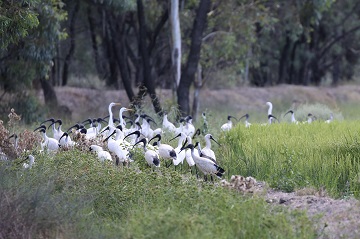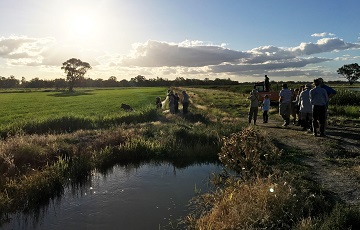 The Bitterns in Rice Project began in 2010 when a Mayrung district rice grower photographed a pair of Australasian Bitterns in his rice crop. Knowing little about these elusive birds he sent the photo to Birdlife Australia, who contacted the Environmental Champions Program (ECP) to investigate how we could work together to learn more about this endangered bird.
The Bitterns in Rice Project began in 2010 when a Mayrung district rice grower photographed a pair of Australasian Bitterns in his rice crop. Knowing little about these elusive birds he sent the photo to Birdlife Australia, who contacted the Environmental Champions Program (ECP) to investigate how we could work together to learn more about this endangered bird.
The ECP obtained funding from a range of organisations to establish population estimates and study these birds’ use of rice crops as surrogate habitat. A steering committee was formed and wildlife ecologist Matt Herring was engaged to lead the field work. Funding partners in this project include Riverina Local Land Services, Murray Local Land Services, RIRDC(AgriFutures), the Norman Wettenhall Foundation, Coleambally Irrigation and Coleambally Landcare. Significant in-kind support has been received from Coleambally, Murray & Murrumbidgee Irrigation, Murrumbidgee Field Naturalists Club, NSW National Parks and Wildlife Service, Murrumbidgee Irrigation Landcare & Murray Landcare Collectives and ECP members.
Significant numbers of Australasian Bitterns use Riverina rice crops as habitat during the growing season with numerous birds found in the Murray, Murrumbidgee and Coleambally irrigation areas. We have also proven that Australasian Bitterns nest and raise their chicks in our rice crops.
A published research paper 'Agriculture, Ecosystems and Environment' (2019) estimates that Riverina rice fields support 500-1000 endangered Australasian bitterns, which make up about 40% of the global population.
2019-20 rice season was the first season of bittern-friendly rice growing incentives.Despite it being another difficult season with drought and low water allocations, we managed to sign up six growers who agreed to meet the criteria for a total of 279 hectares of bittern-friendly rice. In summary, the incentive sites attracted four times as many bitterns as the control sites, and successful breeding was recorded. We also monitored 308 hectares at control sites across seven additional rice farms. In total we had 22 sites – 11 bittern-friendly and 11 controls – and the contrasting results were very encouraging.
A new round of Bittern Friendly rice growing incentives is planned for the 2020-21 season.
This project is supported by Riverina Local Land Services through funding from the Australian National Landcare Program.
Click this link for full details of the Bitterns in Rice project.

Pozible Campaign
During October 2014, the Bitterns in Rice project team successfully raised in excess of $50,000 as a participant in the Landcare NSW-Pozible Environment Collection crowd funding campaign. These funds have been used to satellite track ten Australasian Bitterns. The project has shown that many Bitterns leave their spring summer rice habitat and fly large distances to coastal and inland ephemeral wetlands. The tracking has also shown that some birds like to stay close to their rice fields during winter using habitat created by irrigation infrastructure.

Habitat value under different agronomic practices
Rice crop management practices have been recorded for all crops formally surveyed for Bitterns. Initial findings highlight this bird’s preference for aerially sown crops, or drill sown crops with early permanent water. We believe the earlier flooding of the fields benefits prey development enabling early and ample food supply for successful breeding.
The latest tips for Bittern Friendly Rice growing can be found in the booklet; “Bitterns in Rice the Story so Far 2012-2016”.